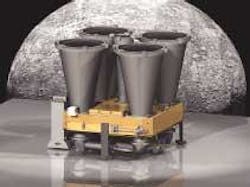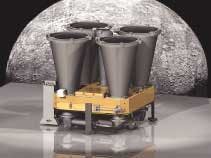Laser altimeter set to study Mercury
Scientists from NASA Goddard Space Flight Center are keen to see how the compact laser altimeter they have put together for the MESSENGER (Mercury Surface, Space Environment, Geochemistry, and Ranging) space mission will handle the trek to Mercury this summer. The MESSENGER spacecraft is scheduled to launch sometime during the first two weeks of August aboard a Boeing Delta II rocket from Cape Canaveral Air Force Station in Florida.
The instrument is based on the Mars Orbiter Laser Altimeter, which mapped the topography of Mars. Xiaoli Sun and colleagues from NASA Goddard have modified the altimeter for the MESSENGER mission; the result is a compact, robust instrument that weighs just 7.3 kg and uses only 23 W of power but can measure to an accuracy of better than a meter at distances up to 1000 km. The instrument uses a diode-pumped Q-switched Nd:YAG laser (1064 nm) that emits 20-mJ, 6-ns pulses at a repetition rate of 8 Hz.
Scientists believe that understanding Mercury—the smallest and oldest planet with the largest daily variations in surface temperature—is crucial to developing a better understanding of how Earth formed, how it evolved, and how it interacts with the Sun. The MESSENGER mission is focused on six key questions: Why is Mercury so dense? What is Mercury's geologic history? What are the structure and state of Mercury's core? What is the nature of Mercury's magnetic field? What are the unusual materials at Mercury's poles? And what volatiles are important at Mercury?
The MESSENGER spacecraft will travel more than 6 1/2 years before it begins to orbit Mercury in March 2011. Once the spacecraft begins its orbit, the laser altimeter will transmit laser pulses toward the planet's surface and four large cones will collect the photons reflected off Mercury's surface. The topography of the planet will be determined from the laser-pulse time-of-flight and the spacecraft orbit-position data. The four-cone receiver-optics design, which feature beryllium tubes and sapphire objective lenses, is designed to maintain focus under large and rapid temperature changes as the spacecraft travels from the dark and cold side of Mercury to the sunny and hot side. Four optical fibers combine the light signal onto a single silicon avalanche photodiode.
In addition to the altimeter, the MESSENGER will carry x-ray, gamma-ray, and visible-IR spectrometers, which will be used to determine the elemental and mineral makeup of rock units that form the surface. The camera will image the previously unseen portion of the planet, and nearly all of the surface will be imaged in stereo to determine the planet's global topographic variations and landforms.

